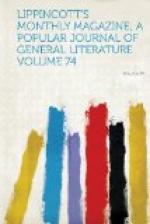The tulip-tree is of such colossal size and it branches so high above ground that it is little wonder few persons, even of those most used to the woods, ever see its bloom, which is commonly enveloped in a mass of large, dark leaves. These leaves are peculiarly outlined, having short lobes at the sides and a truncated end, while the stem is slender, long, and wire-like. The flower has six petals and three transparent sepals. In its centre rises a pale-green cone surrounded by from eighteen to thirty stamens. Sap-green, yellow of various shades, orange-vermilion, and vague traces of some inimitable scarlet, are the colors curiously blended together within and without the grand cup-shaped corolla. It is Edgar Fawcett who draws an exquisite poetic parallel between the oriole and the tulip,—albeit he evidently did not mean the flower of our Liriodendron, which is nearer the oriole colors. The association of the bird with the flower goes further than color, too; for the tulip-tree is a favorite haunt of the orioles. Audubon, in the plates of his great ornithological work, recognizes this by sketching the bird and some rather flat and weak tulip-sprays together on the same sheet. I have fancied that nature in some way favors this massing of colors by placing the food of certain birds where their plumage will show to best advantage on the one hand, or serve to render them invisible, on the other, while they are feeding. The golden-winged woodpecker, the downy woodpecker, the red-bellied woodpecker, and that grand bird the pileated woodpecker, all seem to prefer the tulip-tree for their nesting-place, pecking their holes into the rotten boughs, sometimes even piercing an outer rim of the fragrant green wood in order to reach a hollow place. I remember, when I was a boy, lying in a dark old wood in Kentucky and watching a pileated woodpecker at work on a dead tulip-bough that seemed to afford a great number of dainty morsels of food. There were streaks of hard wood through the rotten, and whenever his great horny beak struck one of these it would sound as loud and clear as the blow of a carpenter’s hammer. This fine bird is almost extinct now, having totally disappeared from nine-tenths of the area of its former habitat. I never see a tulip-tree without recollecting the wild, strangely-hilarious cry of the Hylotomus




